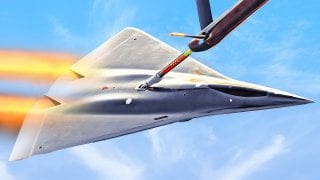The U.S. Air Force's Next Big Problem: NGAD Fighter Shortage?
The U.S. Air Force plans to procure 200-250 NGAD (Next Generation Air Dominance) sixth-generation fighters. Despite concerns over their limited numbers compared to the current fleet of F-16s and F-15s, NGAD fighters are designed to be sophisticated stealth aircraft with advanced data fusion and network connectivity, serving as force multipliers.
Summary and Key Points: The U.S. Air Force plans to procure 200-250 NGAD (Next Generation Air Dominance) sixth-generation fighters. Despite concerns over their limited numbers compared to the current fleet of F-16s and F-15s, NGAD fighters are designed to be sophisticated stealth aircraft with advanced data fusion and network connectivity, serving as force multipliers.
-Each NGAD will operate with uncrewed collaborative combat aircraft, enhancing their effectiveness.
-High costs mean fewer units, but their advanced capabilities should provide significant advantages against potential adversaries like Russia and China.
How Many NGAD Fighters Does the U.S. Air Force Really Need?
The U.S. Air Force is expected to procure between 200 and 250 NGAD (Next Generation Air Dominance) sixth-generation fighters. That’s not a lot.
Consider that the Air Force currently has 841 F-16s in service, and almost 400 F-15s. Some are concerned that the U.S. is procuring too few NGADs, and that the Air Force could find itself shorthanded in a potential conflict against China or Russia.
What can the Air Force do with 200 to 250 NGADs?
Designing the Future with NGAD Fighters
The NGAD is being designed to survive in a modern conflict. The sixth-generation platform will not be a bomb truck or a workhorse, but rather a sophisticated stealth fighter with advanced data fusion and comprehensive network connectivity. The NGAD’s stealth characteristics alone should help ensure the airframe’s survival in a modern conflict.
The U.S. has only lost one stealth aircraft to enemy fire – an F-117 over Yugoslavia in 1999. Otherwise, the enemy has failed to engage U.S. stealth aircraft. Granted, the enemies the U.S. has faced since the introduction of stealth aircraft have been unsophisticated, flying Soviet-era junkers and manning outdated SAM technology. U.S. stealth aircraft like the F-22, F-35, B-2, and F-117 never faced much of a threat.
In a conflict with Russia or China, however, the NGAD would face legitimate threats, including up-to-date aircraft and air defense systems. But the NGAD is being designed to be undetectable to modern detection technology, and if the NGAD’s designers achieve their goals, the system should be highly elusive and difficult for the Russians or Chinese to target.
Targetable or not, the NGAD should have an edge over Russian and Chinese aircraft. The F-22 Raptor is widely considered the best air superiority fighter in operation today. The NGAD is slated to replace the F-22, theoretically widening the gap between the U.S. and its adversaries with respect to air superiority fighter technology. The NGAD should have an edge against Russian MiGs and Sukhois, or Chinese J-15s and J-20s.
And while 200-250 NGADs may not seem like a lot, it’s important to remember that the NGAD is being designed as a force multiplier, capable of making the entire system within which it operates more competent. Speaking of force multipliers, each NGAD will fly with uncrewed collaborative combat aircraft, also known as the loyal wingman platform. So each NGAD will have the abilities of multiple aircraft.
Hard to Replace NGAD Fighters
The 200-250 NGADs that the Air Force is slated to procure will have to be enough: Each unit is expected to cost a few hundred million dollars. Three or four NGADs may cost a billion dollars between them. The NGAD is not an F-16, where the Air Force can feel free to develop and field several hundred. Rather, the NGAD will be more like the B-2 or F-22 – it should be used only when necessary.
So as many taxpayers will tell you, 200 to 250 NGADs will need to be enough. The U.S. military budget is already pushing $1 trillion dollars a year, and it cannot reasonably be expected to swell much more.
The NGAD, if designed in adherence to its lofty ambitions and purpose, should be adequate in more limited quantities.
About the Author: Harrison Kass
Harrison Kass is a defense and national security writer with over 1,000 total pieces on issues involving global affairs. An attorney, pilot, guitarist, and minor pro hockey player, Harrison joined the US Air Force as a Pilot Trainee but was medically discharged. Harrison holds a BA from Lake Forest College, a JD from the University of Oregon, and an MA from New York University. Harrison listens to Dokken.


